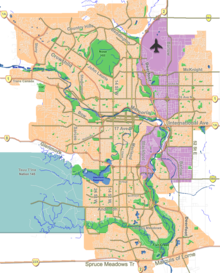Nose Hill
| Nose Hill Park | |
|---|---|

|
|
| Type | Urban park |
| Location | Calgary, Alberta, Canada |
| Coordinates | 51°07′N 114°07′W / 51.117°N 114.117°WCoordinates: 51°07′N 114°07′W / 51.117°N 114.117°W |
| Area | 11.27 square kilometres (4.35 sq mi) |
| Created | 1980s |
| Operated by | City of Calgary |
| Status | Open year round |
Nose Hill Park is the third largest urban park in Canada and one of the largest urban parks in North America. It is a municipal park, unlike Fish Creek, which is a provincial park. Nose Hill Park is located in the northwest quadrant of Calgary, Alberta. It is a natural environment park, commonly regarded as a retreat from city life and a place to enjoy nature.
Sensitive vegetation, terrain, and archaeological sites exist within the park. It contains a significant native rough fescue grassland ecosystem and over 66 native vascular plant species have been found on the hill including parry oat grass, prairie crocus, golden bean, bedstraw and sage.
Grasslands of this nature are considered endangered in North America because more than 95 percent have been lost to cultivation, tree encroachment, pollution, and development. The grassland is one of seven major native habitat types on the hill which together provide an excellent habitat for a variety of animals. Over 198 wildlife species have been identified on the hill.
A large river flowing from the mountains to the west deposited gravels on top of sandstones and shales that formed the hill's bedrock. During the last ice age, about 15,000 years ago, ice sheets wore away the rock and gravel. At the end of the ice age, retreating ice left glacial till on the hill's top. Glacial Lake Calgary was formed in the area and deposited sediments on the side of the hill. A river, later to be known as the Bow, eroded the sediments and helped shape the south side of the hill.
The origin of the hill's name is unclear but common legend tells of a European explorer asking an aboriginal translator the name of the hill seen far off in the distance. The man replied: Nose Hill is the name it was given because from here it resembles the nose of our chief.
In December 1779 a well-known Hudson's Bay Company trader, Peter Fidler, recorded an excursion to the hill he went on with Peigan guides. HBC trader David Thompson wintered at a Peigan encampment on the Bow River in 1787–1788, and in 1800 returned to the area as a North West Company employee. In his journal for the year, Thompson made specific note of Nose Hill. The details of Fidler's journal entry illustrate well how dramatically the region's warm Chinook winds can affect the cold temperatures that characterize winters in southern Alberta. The temperature on the December day of Fidler's visit to Nose Hill was a balmy 14 degrees Celsius (58 degrees Fahrenheit).
...
Wikipedia

